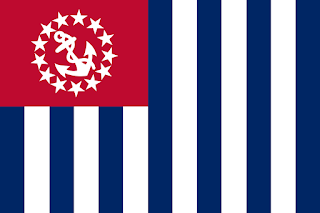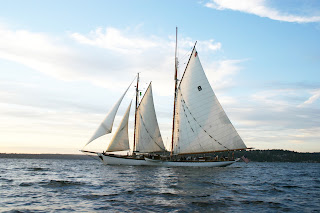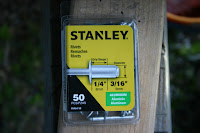
|
|
Sail track for Blake Island trip.
|
|
Since buying Fantasia, our Catalina 22, in the summer of 2014, we've spent the
majority of our sailing time in the northern part of Lake Washington, close to
moorage with the safety and comfort of protected waters. Since we didn't have
a functional steaming light, we never stayed out beyond dusk and just focused
on having fun close to home and learning how to take care of our boat and
operate safely around other craft. This season, many of the upgrades we chose
to work on were those that would enable us to be on the water after dark,
whether sailing, steaming or anchored, and to begin visiting other nearby
locations in Puget Sound.
We went out on our first overnight trip on Fantasia. We chose a relatively
close location,
Blake Island, as our first destination. There were many firsts on this trip; our first
time through the Hiram M. Chittenden Locks (a.k.a. Ballard Locks), our
first sail in Puget Sound, our first overnight stay at a State Park marina,
and our first overnight stay on the boat. It was a chance to really test all
our new electrical upgrades, both AC and DC. The chart plotter enabled us to
accurately determine where we were in relation to shipping and ferry lanes.
We headed out on Saturday morning, pulling away from the dock about 9:40 AM.
headed towards the locks under motor. We wanted to get to the locks as early
as possible, as we'd heard many stories about how busy the locks get on a nice
day and the long the wait to get through them. Although we had been as far as
Lake Union twice before, this was our first time continuing beyond it.
Along the way, there are seven bridges that we need to pass under, but given
our mast height, we only are concerned about the Fremont Bridge. The
clearances on all of the other bridges at the center are well beyond our
masthead at 29.1 feet (plus our VHF antenna) above water level. However, the
Fremont Bridge, at only 30' is a concern for a Catalina 22 with antenna and
anchor light. The water level in the lakes varies up to two feet throughout
the summer boating season, so we can pass under this bridge when water levels
are exceptionally low. We passed under slowly, but the very tip of our
(flexible) VHF whip antenna brushed the bottom of the bridge in one spot. At
higher water level, we could not have made it. Due to this low clearance, the
Fremont Bridge opens on average of 35 times per day making it one of the most
frequently opened bridges in the United States. On the way back, we decided it
was better to have the bridge opened for us.

|
The Fremont and George Washington Memorial bridges after
we motored past them on the way to the locks.
|
Bridges from East to West. Refer to
NOAA chart 18447
for more information on bridge heights and other information.
| Montlake Bridge |
| University Bridge |
| Ship Canal (I-5) Bridge (fixed) |
| George Washington Memorial (Aurora) Bridge (fixed) |
| Fremont Bridge |
| Ballard Bridge |
| Burlington Northern RR Bridge |
We arrived at the Ballard Locks at 11:40am, behind a half dozen or so other
boats jockeying for position to get into the currently loading large lock.
There are two continuously operating locks, one large and one small. We
decided to get in line for the small lock, which had just closed with a full
load of boats heading out, rather than hope to get a spot in the currently
loading large lock. We tied up to the waiting area on the north side. The
small lock turned out to be the better choice, especially for a first time
through the locks.

|
Tied up waiting to go through the small
lock.
|
With fewer boats to load, tie, untie and unload, the small lock cycles through
much quicker than the large lock. In the small lock, the tie down points are
on floats that move with the boats and the water level, so tying up and
managing lines is much easier in the small lock. Going through the large lock,
you must have two 50' lines with eyes and must play out or take in the lines
as the water level changes, whereas with the small lock, 25' lines will
suffice, and they do not have to be managed while the water level changes.
We had to wait about 35 minutes for one full cycle of the locks in each
direction. While waiting for the lock, we were entertained by jumping salmon,
which had recently exited the fish ladder, and a very mischievous seal who had
also decided it would be fun to travel through the locks along with the boats.
Finally it was our turn to load. It took about 15 minutes to get through
the lock, including getting tied up and cycling the lock. Kudos to the locks
staff; they gave friendly direction throughout the process making it a
relatively stress free experience.

|
|
In the small lock, waiting for it to cycle.
|
We motored the remaining way out of the ship canal. By 12:40 we were away from
land and out in beautiful Puget Sound. There is a lot more space on
Puget Sound than Lake Washington, so although there are many boats around,
they aren't likely to be passing nearly as closely, or nearly as frequently as
the do on the lake. There is a lot of room to maneuver, and most of the
boaters take advantage of that fact.
One of the most surprising things about being out on Puget Sound was how
little we were impacted by wake. In the confines of Lake Washington, on any
nice boating day, the surface of the lake gets worked up into a frenzy from
all of the power boats and jet skis. This is not the case in Puget Sound. The
wakes are few, mainly generated by the occasional ferry or container ship
passing and those provided mainly a gentle rolling lift and fall.
Using our new chart plotter, we determined our desired heading and raised
sail. The wind was blowing from the North-Northeast, perfect for a run South
towards Blake Island. Winds were very light, but thankfully the current was
with us. We ran southwards wing and wing for a while, then decided to furl the
Genoa and raise the asymmetrical spinnaker. As we made our way south,
the Seattle skyline came into view. Ferries bustled back and forth, moving
cars and people from the mainland to Bainbridge Island or Bremerton and back.
Container ships came and went, as did various tugboats. Three cruise ships
could be seen on the Seattle waterfront, preparing to head for Alaska. The
winds were light, and we only traveled between two and four knots.

|
|
Blake Island to the port, gennaker flying, ferry ahead.
|
While sailing, we had the VHF radio working for the first time with the new
wiring and antenna. We listened in as three separate boats called the Coast
Guard for help. One had run out of fuel in Puget Sound somewhere. Two others
were also disabled, near Anacortes and Camino Island. We hope to never
need that kind of help.
We arrived at Blake Island simultaneously with two other sailboats at about
4:30 PM. We all dropped sail and jockeyed to get into the dredged passage to
the docks, having to make way for the Argosy Good Times II to come out. We got
in first and found that they had 30' of dock space left...just enough for one
Catalina 22. The boats behind us had to settle for mooring buoys that surround
the island, which actually would have been problematic for us since we do not
have a dinghy. There is a couple that acts as volunteers running the harbor,
helping to tie up, and giving the rundown on how things work.
Moorage at Blake Island is $0.70 a foot, plus $6 for shore power, per day. You
pay at a pay station on shore. There are bathrooms with running water. Hot
showers are available for $0.50 for three minutes by getting tokens from a
machine at the ranger station. The ranger station also has a store that is
open for three hours a day for essentials such as sodas and snacks. We checked
on the Tillicum Village evening performance, but it was full. (More on this in
a bit.) After thinking on it a bit, we decided to see the show on Sunday and
leave in the afternoon.

|
Seattle from Blake Island,
the entrance to the moorage in the foreground.
|
Blake Island is a 475 acre state park, and the only access is by boat. There
are tour boats from Bremerton and Seattle that come out for the Tillicum
Village performances, that can also be used as a ferry. Otherwise, the only
way to the island is by private boat. It is wooded, with hiking trails. There
are three areas to camp on the island. Raccoons abound, and they are
aggressive about getting into food. No food must be left accessible on deck or
in unprotected areas. If you are moored away from the dock, beware that the
raccoons can swim and still get to any unprotected food. There are also deer
on the island, but they are not nearly as aggressive.
We settled in for the evening, putting a new 8'x10' tarp over the boom for
shade, as well as the pop-top curtain. The curtain (which is actually made of
vinyl) encloses the cabin with the pop-top up, giving more head room when
docked, as well as gives a zipper opening instead of needing to put in the
crib boards when closed up. It also gives shelf space next to the mast below
the pop-top, but inside the pop-top that allows repositioning some of the
stuff that is not needed.We hooked up to shore power, using our AC wiring.
This allowed us to recharge the batteries consumed by the interior lights,
recharging devices, VHF, and chart plotter.

|
|
Blake Island trail.
|
We made reservations for the Sunday performance at Tillicum Village, then went
for a short walk across the North of the island. There are well tended wide
trails, under a Douglass fir canopy. You can see Mount Baker to the North,
Seattle to the Northeast, the Olympics to the West. Mount Rainier is to the
East of the island. After the walk, we sat in the cabin and played cards until
bed time. Taylor decided to sleep in the cockpit, which she later regretted,
since it got cold. The wind kicked up during the night, but was still by
morning.
During the night, the tide had fallen. Two small power boats that had tied up
to the shore were left high and dry on the beach. They eventually were pushed
back into the water. We were reminded to keep in mind the tides for future
trips, which we do not worry about in the lake.

|
Fantasia tied up to the left, the family in the center, and note
boats to the right.
|

|
|
The same boat the next morning.
|
In the morning, we ate breakfast on the boat, and went for a short walk on the
East side of the island. There are wonderful views of Seattle and Mount
Rainier. We made the boat ready to head home. We paid for another day of
moorage (but not power), as check out time is 1 PM, and the Tillicum Village
performance concluded about 2 PM.
Tillicum Village is a Native American long house where they cook salmon using
traditional techniques around open fires. Meals are from a buffet, with shared
tables. After lunch, there was Native American dancing performance on stage.
Greg had seen the performance here many years ago, but it has changed since
then. The performance now combines live dancing with AV going on a large
screen behind the performers. This requires fewer people, but it worked. In
2009, Argosy acquired the rights to Tillicum Village, so were no longer
just providing the transportation to the island. It is a little on the
expensive side for what they provide, but it is worth seeing once, especially
if you have visitors from outside the Pacific Northwest. The food was good.

|
U.S.S. John C. Stennis near Bainbridge Island
headed to Bremerton.
|

|
|
This won't fit in my bath tub.
|
After the performance, we headed out. Winds were still light, but a hair
stronger than the day before. The winds were still coming from the North, so
we had to tack to get back toward the locks. We had to dodge a few ferries
cutting between Seattle and Bremerton, and a few cruise ships were in the
distance headed off to Alaska. But then Sandi said, "That's an aircraft
carrier headed our way." Sandi had been in the Navy for 10 years, so knew an
aircraft carrier when she saw one even from a long way off. Sure enough,
coming South was a Nimitz class carrier, headed toward its home port in
Bremerton.
The
U.S.S. John C. Stennis
(CVN 74), a 103,300 ton, nuclear powered supercarrier, was quite a sight as it
steamed past us to the West. When you look at at a carrier like this on
profile, especially from the stern, it does not look like the thing should be
able to float. The tower, perched far out on one side makes it look like it
should simply tip over. At one point, we had the aircraft carrier passing to
our West, three cruise ships passing us from the East, headed north, and two
ferries passing between Seattle and Bainbridge Island.

|
|
In the small lock headed in.
|

|
|
Stern view of the Stennis.
|
We dropped sail and made our way back through the locks without incident. As
we approached the Fremont Bridge, we decided that we really need to have the
bridge raised and gave the long-short signal with our air horn. The bridge
attendant had us wait for a while, before raising the bridge. A terrific sense
of power sets in as we mess up all the driver's commutes! We motored home and
arrived just after sunset, using our new LED navigation lights for the first
time. Waves in the lake were actually pretty heavy, as we had water splashing
over our bow.

|
|
Raising the Fremont Bridge.
|
It was about as perfect a weekend as we could have hoped for, and the perfect
trial for getting out of the lake and venturing forth. For next season, we
will have to plan a more extensive trip in the San Juans.































































